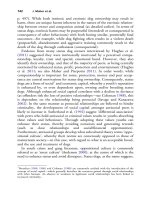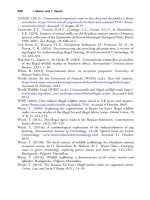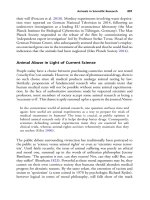The palgrave international handbook of a 118
Bạn đang xem bản rút gọn của tài liệu. Xem và tải ngay bản đầy đủ của tài liệu tại đây (28.58 KB, 1 trang )
108
A. Arluke et al.
. . . cats are perceptible on every hand . . . cats with eyes, without eyes, earless
and cats of every description skulk in the black nooks or rush out and disappear
in sudden panic. And all the time, from sunrise to sunrise, an aromatic and
voluminous cloud of feline exhalation is rafted down the stairs into the street
(Anonymous 1875, p. 4).
Such accounts occur in modern media on an almost daily basis (Arluke et al.
2002) yet the impact of the accumulation of large numbers of animals on
human health and animal welfare has only recently been recognized as a
serious concern. The issue was first described in the scientific/medical literature by Worth and Beck (1981), who characterized it as ‘multiple animal
ownership’ in describing 31 case histories of problems presented to the New
York City Department of Health and the American Society for the Prevention
of Cruelty to Animals (ASPCA). Such individuals were later characterized as
‘animal collectors’ in publications aimed at animal welfare professionals
(Lockwood and Cassidy 1988) and veterinarians (Lockwood 1994).
Patronek (1999) and the Hoarding of Animals Research Consortium
(HARC) introduced the term ‘animal hoarding’ as a designation that was
more consistent with existing medical, psychological and psychiatric
nomenclature since the term ‘collecting’ more appropriately described
accumulations associated with benign hobbies (Frost et al. 2000;
Nordsletten and Mataix-Cols 2012). Animal hoarding was formally defined
by the following criteria (Patronek 1999; HARC 2002):
• Having more than the typical number of companion animals.
• Failing to provide even minimal standards of nutrition, sanitation,
shelter and veterinary care, with this neglect often resulting in illness
and death from starvation, spread of infectious disease, and untreated
injury or medical condition.
• Denial of the inability to provide this minimum care and the impact of
that failure on the animals, the household and human occupants of the
dwelling.
• Persistence, despite this failure, in accumulating and controlling animals.
Subsequently, there was increased attention from other professional
disciplines to the widespread problems caused by animal hoarding.
These problems have been addressed by lawyers (Patronek 2001),
social workers (Fleury 2007), adult protective service workers (Boat
and Knight 2001; Lockwood 2002), firefighters (Merrill 2012) and
others.









